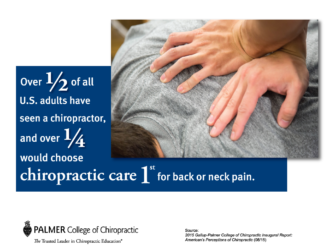Patients with Chronic Pain and Disability Reap Benefits From Continued Chiropractic Care

Generally, when a person experiences pain or illness, the goal is to eliminate it. For many conditions, health care services are geared towards curing an illness or healing an injury, with the best case scenario resulting in the services no longer being needed. However, there are some instances where patients are unable to attain a 100% return to health.
When a part of the body is damaged in a way that cannot be repaired, it may result in the patient experiencing chronic pain. For years, opioids were promoted as the go-to solution for these patients. In an effort to reduce pain without those medications, some have resorted to severely restricted activities. Either way, strong, potentially addictive medications or limiting a patient’s lifestyle can have negative consequences not only for the patient, but also for the individual’s loved ones and their ability to work or enjoy the things they enjoy.
Thankfully, there are other options for ongoing care that can bring positive benefits for many of these patients and chiropractic care is one of them. Chiropractic care is a discipline known for its natural, non-invasive treatments that have been successful in controlling pain levels and helping patients maintain their regular activities.
To explore the effectiveness of ongoing chiropractic care, sometimes referred to as maintenance care, a small Canadian study evaluated its possible impact on overall pain and disability for low back pain (LBP) patients. The patients received a series of spinal manipulative therapy (SMT) treatments, also known as spinal manipulation or a chiropractic adjustment.
The study involved 30 individuals with non-specific chronic low back pain who were separated into two groups. Group one was monitored for 4 weeks to determine the effect of time on their pain and disability levels. The patients then received 12 SMT treatments over an intensive 1-month period. No additional treatment was administered in the following 9 months.
Group two patients received the same number of treatments over the same intensive 1-month period; however, this group also received maintenance SMT every 3 weeks for the following 9 months.
For both groups, pain was assessed using a visual analog scale, and disability was gauged by a modified Oswestry questionnaire.
After the initial month of observation, there was no real change in the pain and disability levels for the study participants. Both groups showed reduced pain and disability after the initial month of treatment. Both groups retained pain relief through the 9-month follow-up.
However, only Group Two, which received maintenance SMT care, reported a continued reduction in disability scores. Disability levels of those who did not receive maintenance care returned to pretreatment levels.
Researchers concluded that intensive SMT is effective for chronic low back pain. Additionally, maintenance SMT after the initial intensive phase, may be beneficial to patients in order to maintain disability levels. Due to the small size of the study, authors recommended additional research to confirm these findings.
In 2011, a subsequent study titled, Does maintained spinal manipulation therapy for chronic nonspecific low back pain result in better long-term outcome?, was published in the journal Spine. This study involved twice the number of patients, and reported very similar results. Researchers took 60 patients who had chronic, nonspecific low back pain that had lasted at least 6 months and randomly divided them into three groups.
Group 1 received 12 treatments of sham spinal manipulation over a 1-month period with no additional treatment.
Group 2 received 12 SMT treatments over a 1-month period with no additional treatment.
Group 3 received 12 SMT treatments over a 1-month period, followed by “maintenance spinal manipulation” every other week for the next 9 months.
Researchers gathered pain and disability scores, generic health status as well as back-specific patient satisfaction when the patient began the study and repeated these measures at 1, 4, 7 and 10 months.
Results supported chiropractic care for chronic LBP overall. More specifically, at the 1-month mark, patients in groups that received real SMT experienced “significantly lower pain and disability scores” than the group that received sham treatments. However, only the maintenance SMT group showed “more improvement in pain and disability scores” at the 10-month evaluation while those who did not receive the maintenance SMT care returned to near pretreatment levels.
Researchers in the Spine study concluded that SMT is effective in treating chronic LBP. Additionally, they state: “To obtain long-term benefit, this study suggests maintenance SMT after the initial intensive manipulative therapy.”
 A 2015 poll by Gallup about American’s perceptions of chiropractic, commissioned by Palmer College of Chiropractic, showed that more than half of U.S. adults view doctors of chiropractic positively and agree they’re effective at treating neck and back pain. Moreover, the study showed that 31 percent of chiropractic users want to see a chiropractor on a regular basis, even if they don’t have pain.
A 2015 poll by Gallup about American’s perceptions of chiropractic, commissioned by Palmer College of Chiropractic, showed that more than half of U.S. adults view doctors of chiropractic positively and agree they’re effective at treating neck and back pain. Moreover, the study showed that 31 percent of chiropractic users want to see a chiropractor on a regular basis, even if they don’t have pain.
A four-year study, “Clinical and Cost Outcomes of an Integrative Medicine IPA,” published in the Journal of Manipulative and Physiological Therapeutics demonstrates that individuals who use chiropractic and other integrative medicine experienced significantly greater wellness than non-users. A review of claims and patient surveys showed that when compared with normative conventional medicine independent practice association, those who use chiropractic or other integrative medicine:
- Saw a decrease of 43.0% in hospital admissions
- Experienced 4% fewer hospital days
- Had 2% fewer outpatient surgeries and procedures
- Reduced pharmaceutical costs by 51.8%
As these studies support, chiropractic care is effective in relieving LBP, even among those with chronic pain. Additionally, after an intensive treatment period, SMT care can be spread out to allow the patient to maintain pain and disability reduction. This can allow patients to continue to work and enjoy activities with their families that LBP may have been keeping them from doing. In addition to the SMT, the doctor of chiropractic may recommend exercises, stretches or other lifestyle changes to help the patient have the most complete pain relief and maintaining an active life.
If you or a loved one is experiencing LBP, whether acute or chronic, talk to your chiropractor about ways that chiropractic care may benefit you.
Think your chronic condition and symptoms can only be remedied by painkillers? It doesn’t have to be an either/or situation. Your doctor of chiropractic can work with your other health care providers to offer you the best possible care. In time, as your condition changes, your care team can review your treatment plan and adjust accordingly. You may be surprised at how effective the SMT is and be able to reduce or even eliminate medications as time progresses.
If you have to have long term pain relief, chiropractic is a great option. It is cost-effective and you don’t have to worry about addiction or organ damage from strong pain medications. If you are not already established with a chiropractor, find a TCA member doctor near you at www.tnchiro.com/find-a-doctor/.
REFERENCES:
Descarreaux M, Blouin JS, Drolet M, Papadimitriou S, Teasdale N. “Efficacy of preventive spinal manipulation for chronic low-back pain and related disabilities: a preliminary study.” J Manipulative Physiol Ther. 2004 Oct;27(8):509-14. https://www.ncbi.nlm.nih.gov/pubmed/15510094
Senna MK, Machaly SA. “Does maintained spinal manipulation therapy for chronic nonspecific low back pain result in better long-term outcome?” Spine (Phila Pa 1976). 2011 Aug 15;36(18):1427-37. doi:10.1097/BRS.0b013e3181f5dfe0.
Gallup-Palmer College of Chiropractic Inaugural Report: Americans’ Perceptions of Chiropractic. July 2015.
Sarnat R; Winterstein J. Clinical and Cost Outcomes of an Integrative Medicine IPA. J Manipulative Physiol Ther. Volume 27, Issue 5, June 2004, Pages 336-347. https://doi.org/10.1016/j.jmpt.2004.04.007